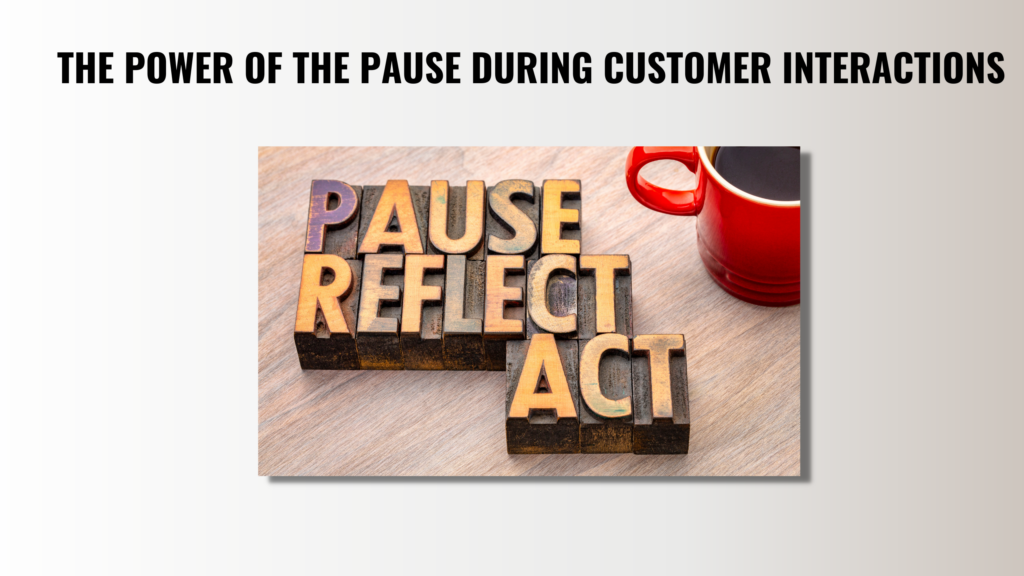Some customer interactions go uphill, some go downhill, while others go sideways. Moderation of the energy within the interaction, by customer contact employees, is essential to achieving a harmonious, solution-driven and courteous landing, where both customer and business come away with acceptable value.
The practice of intentional pausing, using a series of short, coordinated steps during exchanges with customers can harness the “power of the pause” to land good customer outcomes.
So, what is this pausing technique and what makes it so powerful?
Whenever individuals interact, the efficacy of the psychological outcomes of these exchanges often lies in the space between stimulus and response. This is the space within which the pause and its power reside. Emotions occupy quite a significant amount of this space and individuals involved in the interactions should possess the awareness to recognize just how much influence an emotion can wield over the choice of behaviour, from one moment to the next. This awareness is called emotional self-awareness and falls within the rubric of emotional intelligence.
In the case of customer interactions, the pause is most effective whenever a situation requires a response that will de-escalate, redirect or reset the distribution of emotional energy, so that the individuals involved regain emotional composure.
In the case of customer interactions, the pause is most effective whenever a situation requires a response that will de-escalate, redirect or reset the distribution of emotional energy, so that the individuals involved regain emotional composure. Customer contact employees who master the pausing formula and supplement it with adequate product knowledge and problem-solving skills, tend to have better customer outcomes. The driving force in these interactions becomes the ability to remain so composed emotionally, that one can breeze through exchanges with customers.
Mastering the pause during adverse interactions requires practice and challenges individuals to resist the impulse to react to the people, situations and other stimuli that cause people generally, to be triggered emotionally. But first, an individual must become aware of the stimuli that generate a rise in his or her emotional state. In other words, the unconscious must become conscious.
Customer contact employees who master the pausing formula and supplement it with adequate product knowledge and problem-solving skills, tend to have better customer outcomes.
Next, there should be a determination of whether a stimulus qualifies for a small, medium, large response, or no response at all. Just this act of simple internal enquiry helps to slow an individual down emotionally and can invite rational thinking to inform the design of a response. Conserving energy is critical at this stage.
A subsequent step involves contextual intelligence. In responding to the stimulus, it’s useful to figure out how much of the information presented is split between fact, fiction and ambiguity. Context matters and applying a prismatic view to situations leaves space for acknowledging both the known and the unknown.
While this step may be a case of guessing in the dark, it’s still a worthwhile consideration. Suspending personal bias, assumptions and jumping to conclusions about the person or situation during the interaction, is a part of this step as well. We know how these peculiarities can skew perception.
Mastering the pause during adverse interactions requires practice and challenges individuals to resist the impulse to react to the people, situations and other stimuli that cause people generally, to be triggered emotionally.
We’re now at a point where an individual and more importantly, a customer contact employee, would have created the psychological space needed to choose his or her response. Whenever individuals navigate to this spot successfully, they get to choose their next action and be intentional in their behaviour. They respond, instead of react to adverse stimuli.
Pausing has wide application and utilitarian value across both personal exchanges and public engagements. Personal scenarios as in two individuals conversing and public scenarios, as in the exchanges between internal customers and as in the exchanges between customer contact employees and external customers.
I imagine that you may be saying to yourself that this pausing technique has so many steps and may take so much time, that it defies the concept of an actual pause. Shouldn’t a pause be a momentary action? Well, typically, we think of a pause as having a short time span, but really, a pause just means a break between actions.
How about taking on the first challenge by becoming really self-aware of your emotional triggers, the stimuli for the triggers and your typical resultant reaction?
A good start to mastering the “power of the pause” would be to focus on mastering one step at a time.
How about taking on the first challenge by becoming really self-aware of your emotional triggers, the stimuli for the triggers and your typical resultant reaction? Make a mental note to notice whenever the reactive behaviour occurs and set a target to interrupt the behaviour by pausing and resetting emotionally. No point in being ruled by emotions.
Just this act of punctuation, creates the opportunity to regain control over the editing of one’s behaviour and when added to other skills, takes interaction outcomes to successive levels of excellence, that go from better, to good and ultimately, to great.

